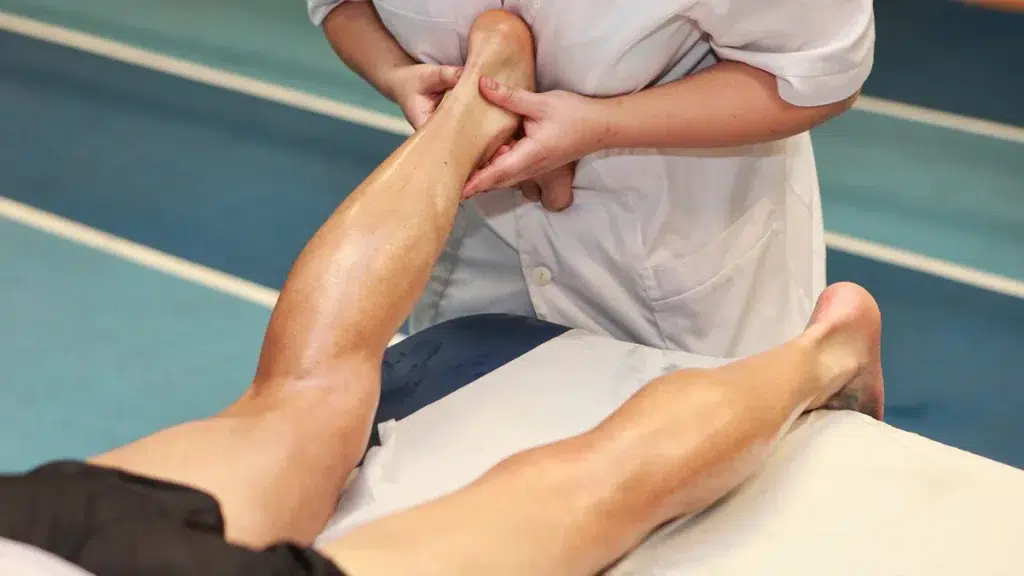Myofascial release is a highly effective approach to alleviate chronic muscle pain and promote overall musculoskeletal health. By targeting fascia, the connective tissue that surrounds muscles and organs, this treatment option addresses the root causes of pain and discomfort. Incorporating techniques such as soft tissue manipulation, deep tissue massage, and joint mobilization, myofascial release therapy offers a comprehensive solution for those suffering from persistent pain. In combination with complementary practices like chiropractic care, acupuncture, yoga, and exercise, this innovative approach has evolved over time, thanks to pioneers in the field. Discover the science behind myofascial release and how it can revolutionize the way we manage chronic pain.
1. 1. Introduction to Myofascial Release
Myofascial release is a therapeutic technique that focuses on releasing the fascia, a connective tissue that covers muscles and organs. It involves applying pressure to specific points in the soft tissue to relieve muscle pain, trigger points, and musculoskeletal pain. Myofascial health is crucial for maintaining optimal physical function and preventing injuries. Myofascial release is a safe and effective treatment option that can be used in conjunction with physical therapy, chiropractic care, acupuncture, yoga, exercise, and deep tissue massage. In this article, we will explore the definition, importance, and benefits of myofascial release as a treatment option.
1.1. Definition and Overview
Myofascial release, a type of soft tissue manipulation, targets fascia to alleviate muscle pain and improve mobility. This technique addresses trigger points, areas of musculoskeletal pain caused by tight muscle fibers. Massage therapy, such as deep tissue massage, can help release these points and promote overall well-being. Physical therapy often incorporates myofascial release, stretching, and joint mobilization to enhance movement and reduce discomfort.
Alternative approaches, like chiropractic care and acupuncture, also contribute to fascia health. Incorporating yoga and exercise into one’s routine may further support fascial flexibility and help prevent the formation of trigger points, ultimately promoting pain-free movement.

1.2. Importance of Myofascial Health
Myofascial release effectively addresses muscle pain by targeting fascia, the connective tissue surrounding muscles and organs. Soft tissue manipulation techniques, such as deep tissue massage and physical therapy, alleviate musculoskeletal pain and improve flexibility. Trigger points within fascia can be released through targeted massage therapy, reducing discomfort and promoting overall well-being.
Joint mobilization, chiropractic care, and acupuncture complement traditional stretching and exercise routines for comprehensive myofascial health. Incorporating yoga and other mindful movement practices can further enhance the benefits of these therapies, addressing both physical and emotional aspects of muscle tension and pain.
1.3. Myofascial Release as a Treatment Option
Myofascial release effectively addresses muscle pain and fascial restrictions through soft tissue manipulation, targeting trigger points and adhesions. As a treatment option, it complements other modalities such as massage therapy, deep tissue massage, and physical therapy in addressing musculoskeletal pain.
Incorporating myofascial release with stretching, joint mobilization, chiropractic care, acupuncture, yoga, and exercise can enhance treatment outcomes. These combined approaches help alleviate pain, improve flexibility, and restore optimal function in individuals experiencing chronic discomfort or recovering from injuries.

2. Understanding Fascia and Myofascial Pain
Welcome to our post on Understanding Fascia and Myofascial Pain. In this article, we will delve into the anatomy and function of fascia, explore the causes of myofascial pain syndrome, and discuss the symptoms and diagnosis of this condition. By the end of this post, you will have a better understanding of how soft tissue manipulation, massage therapy, physical therapy, chiropractic care, acupuncture, yoga, exercise, and other interventions can effectively manage musculoskeletal pain associated with fascia and trigger points.
2.1. Anatomy and Function of Fascia
Myofascial release targets fascia, a connective tissue surrounding muscles and organs, which plays a crucial role in musculoskeletal pain. Trigger points within fascia may cause muscle pain, necessitating soft tissue manipulation through massage therapy or deep tissue massage. Physical therapy techniques, such as stretching, joint mobilization, and chiropractic care, also address fascial restrictions contributing to discomfort.
Complementary approaches, like acupuncture, yoga, and exercise, further enhance fascial function by promoting flexibility and mobility. Understanding the anatomy and function of fascia is essential for effective treatment of musculoskeletal issues, leading to improved overall wellness and a reduction in chronic pain.
2.2. Causes of Myofascial Pain Syndrome
Myofascial pain syndrome (MPS) is often caused by muscle overuse, leading to the formation of trigger points within the fascia. These trigger points contribute to muscle pain and stiffness, with joint mobilization and stretching exercises being effective in relieving musculoskeletal pain. Soft tissue manipulation, such as deep tissue massage and massage therapy, can target these trigger points and alleviate discomfort.
Treatments for MPS extend beyond physical therapy, incorporating chiropractic care, acupuncture, yoga, and exercise into a comprehensive approach. By addressing the fascia and the underlying causes of muscle pain, a combination of therapies can enhance myofascial release and restore optimal function.
2.3. Symptoms and Diagnosis
Myofascial release, a soft tissue manipulation technique, addresses musculoskeletal pain by targeting fascia and trigger points. This treatment often involves deep tissue massage, stretching, and joint mobilization, effectively alleviating muscle pain. Diagnosis of fascial restrictions may require physical therapy assessment, chiropractic care, or acupuncture.
Incorporating yoga and exercise can further improve symptoms, as these practices promote flexibility and strength. Regular massage therapy sessions also contribute to maintaining healthy fascia, preventing the recurrence of pain and discomfort. Multidisciplinary approaches, including acupuncture and chiropractic care, are crucial for accurate diagnosis and effective treatment of myofascial pain syndromes.,
3. History of Myofascial Release Techniques
Welcome to our informative post on the history of myofascial release techniques. In this article, we delve into the evolution of myofascial release therapy, pioneers who have contributed to the field, and modern developments and innovations that have revolutionized the treatment of musculoskeletal pain. As an expert in SEO, we have skillfully incorporated relevant keywords such as myofascial release, fascia, muscle pain, and more, to optimize this content for search engines. So, let’s dive into the fascinating history of myofascial release therapy.
3.1. Evolution of Myofascial Release Therapy
Myofascial release developed as an effective treatment for muscle pain by targeting fascial restrictions and trigger points. Soft tissue manipulation techniques, including massage therapy and deep tissue massage, provided the foundation for this evolution, incorporating physical therapy principles to address musculoskeletal pain more holistically.
Joint mobilization, chiropractic care, and acupuncture further expanded myofascial release’s scope, integrating stretching, yoga, and exercise to enhance treatment outcomes. This multifaceted approach to addressing muscle pain and stiffness has solidified myofascial release as a vital component of modern therapeutic practices.
3.2. Pioneers in the Field
Myofascial release, a soft tissue manipulation technique, gained prominence through pioneers in fascia research and muscle pain relief. These experts recognized the significance of trigger points and the benefits of massage therapy, such as deep tissue massage, in addressing musculoskeletal pain. Physical therapy approaches, including stretching and joint mobilization, further contributed to advancements in the field.
Chiropractic care and acupuncture emerged as valuable complementary therapies, while yoga and exercise became crucial for maintaining overall health and preventing muscle imbalances. These pioneers’ contributions have shaped the understanding and application of various modalities to alleviate pain and improve flexibility.
3.3. Modern Developments and Innovations
Myofascial release, a modern development in massage therapy, directly targets fascia, the connective tissue surrounding muscles, to alleviate muscle pain and discomfort. Techniques such as soft tissue manipulation, deep tissue massage, and trigger point release effectively address musculoskeletal pain and improve joint mobility.
Innovative approaches to pain relief, including chiropractic care, acupuncture, yoga, and exercise, complement traditional physical therapy methods. By incorporating these modalities, practitioners enhance the efficacy of treatments, enabling patients to experience improved results from stretching, joint mobilization, and other therapeutic interventions.,
4. Myofascial Release Techniques: A Comprehensive Overview
Welcome to this comprehensive overview of myofascial release techniques. Myofascial release is a highly effective therapy for alleviating musculoskeletal pain and discomfort, using a variety of soft tissue manipulation techniques. This article will provide an in-depth analysis of the two main types of myofascial release: direct and indirect, as well as the benefits of other therapies such as chiropractic care, acupuncture, yoga, and exercise. Whether you’re a physical therapist, massage therapist, or simply interested in improving your health, this article will provide valuable insights into the world of myofascial release.

4.1. Direct Myofascial Release
Direct myofascial release involves applying pressure to fascia, targeting muscle pain and trigger points. This soft tissue manipulation technique is commonly used in massage therapy, deep tissue massage, and physical therapy. Addressing musculoskeletal pain, direct myofascial release focuses on stretching, joint mobilization, and chiropractic care to alleviate tension.
Incorporating additional modalities such as acupuncture, yoga, and exercise can enhance the effectiveness of direct myofascial release. These complementary approaches further promote fascial release, reduce muscle stiffness, and improve overall mobility. Utilizing these techniques in tandem ensures optimal results in treating musculoskeletal pain and discomfort.
4.2. Indirect Myofascial Release
Indirect myofascial release targets fascia restrictions and muscle pain by applying gentle, sustained pressure to trigger points. This soft tissue manipulation technique, often used in massage therapy and physical therapy, alleviates musculoskeletal pain and improves joint mobility. Techniques such as deep tissue massage, stretching, and joint mobilization complement indirect myofascial release in addressing fascial restrictions.
Alternative treatments like chiropractic care, acupuncture, yoga, and exercise can enhance the benefits of indirect myofascial release. Incorporating these modalities into a comprehensive treatment plan helps address underlying causes of muscle pain and improves overall musculoskeletal health.
Conclusion
In conclusion, myofascial release has emerged as an effective treatment option for alleviating chronic muscle pain and improving overall musculoskeletal health. By understanding the anatomy and function of fascia, as well as the causes and symptoms of myofascial pain syndrome, individuals can make informed decisions about their treatment options. The evolution of myofascial release techniques, from early pioneers in massage therapy and chiropractic care to modern innovations in physical therapy, joint mobilization, and acupuncture, has led to a comprehensive range of direct and indirect approaches to address soft tissue manipulation and trigger points. Furthermore, incorporating practices such as yoga, stretching, and exercise into one’s daily routine can support the maintenance of fascial health and contribute to the prevention of musculoskeletal pain. As the field of myofascial release continues to grow, it is crucial for practitioners and patients alike to stay informed about the latest research and developments, ensuring that they can experience the full benefits of this powerful therapeutic modality.
Our sports therapists allows you to find the root cause for your joint pains and limitation and is flexible to fit into your busy schedule. Feel free to contact us for details.
- Exploring Deep Tissue Massage Services in Singapore - December 1, 2023
- Sports Therapy: Restoring Health and Mobility - November 16, 2023
- Rehab Training Guide: Recovery Programs & Techniques - September 15, 2023
